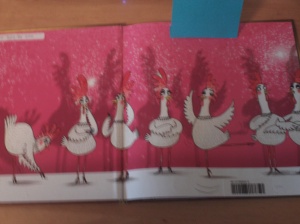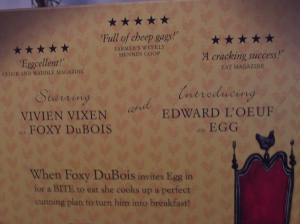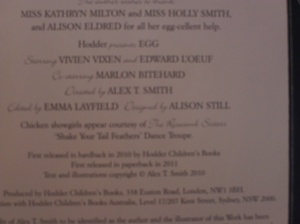
This is ‘Egg’ by Alex T Smith. It is very very lovely (as is all of his work) but what makes this one shine (and inspired this post) is the use of paratexts in this book.
“Paratexts?” I hear you say, “What are these paratexts you talk of?”
Take a seat my intrigued friend!
Basically (very basically and somewhat sweepingly) a paratext is everything apart from the story itself. This would include things like the front cover, the spine, the front papers and the endpapers. Everything that isn’t ‘obviously’ part of the story itself. Things you pass through (the liminal space of the story if you will) to get to the story itself. It’s a term defined by Gerard Genette who is muchos interesting on the topic.
Did you spot those inverted commas around obviously? That’s because a paratext may not look like it’s part of the story. But it is. It really, really is. See, there’s a world of things that colour your reading of a book before you’ve even got to the first page. The front cover. Whether it’s displayed face out, or spine only. There’s a reason why picture books are displayed face out in libraries, they’re designed to catch the eye. Everything about this front cover (Fig. 1) says read me . The way the lettering leads towards the page edge, the way the figure (who we don’t know yet) fills up the left hand side of the page but points, quite brilliantly, towards the page edge. Look at the lines here, the obvious sight line (the figure focuses on the title egg because it’s interesting! and so should you!) and the less obvious lines. The way her snout is basically a massive arrow across the page, telling you to open this book and find out what’s going on. This front cover is brilliant, just brilliantly done in such a small, tight space.

Once inside, we see Fig. 2. If you could do me the favour of ignoring the blue thing, the barcode and the top left sticky thing which have all been stuck into the book by my library, that would be great. But wait, hang on, if we’re talking about paratexts, then these all count in our reading and shouldn’t be ignored . What do these tell you about the book? They tell you that it’s a library one which tells you that this book will be viewed by lots of readers. And that all colours your reading, because if you’ve picked this up, you’ve picked it up from the library which is somewhere you specifically have to go, which all suggests you are already engaged in what this book can do. Our reading is already sliding towards positive engagement because we are positively engaged with this book.
Have a think about what’s going on here. We’re already being shown an idea of what the story is going to be about, before we’ve ‘read’ any of it, and we’re being given a whole little world of stories in every single moment. The chickens are arranged in a performative pose (one of them already performing!), with their shadows cast behind them. The positioning of the shadows suggests some sort of front light directed from in front of the book (from the reader), and so this is where this starts to get (even more) interesting. (Sidebar: note how the horizontal line across the bottom of the page, links with the front cover and provides continuity to pull us into the book) Fig 2. is starting to sing about performance,maybe a dance group, showgirls, backlit against a sparkling pink curtain before they go on. I love it. It’s like a chicken Moulin Rouge. So. Brilliant.

After that, we see Fig. 3. Here the lettering of the front cover is repeated but this time it’s juxtaposed with that twirly ornate lettering of the credits. And they are credits, genuinely, because you start to get the emphatic realisation that Smith is playing on film elements (something spectacularly done so on the back cover – see Fig 4). Note the way that on this title page, it’s a “book by” and “starring” and “introducing”. The filmic connotations of this are so, so luscious. It heightens the ‘fictional’ nature of the story, the ‘constructed’ nature of the story, and lets the adult reader start to enjoy the little puns on the actors names. Vivien Vixen playing Foxy DuBois. Edward L’Oeuf as Egg. There’s so much here that is very subtly and fabulously done.

Also, to briefly return to the lettering, there’s some subtle clues here as to the story. Despite everything, it is a book about the EGG. The title has barely moved position from the front cover, Foxy DuBois is still obsessed with it (note where her eyes go, always). The EGG title dominates the page, even with the world of things that are going on. The Egg is our protagonist. And Foxy really, really wants that Egg.
Now, my pictures are a bit rubbish for this next part for which I apologise, but oh, oh, if you ever have this book in your hands, I implore you to wallow in the frame on the left hand side (Fig 5.). This is where Smith goes to town with the whole film thing and he does so spectacularly. We have a note telling us that the chicken showgirls are appearing courtesy of The Rosecomb Sisters ‘Shake Your Tail Feathers’ dance troupe, that the book has been a co-production between Hachette Children’s Books and Fox and Hounds Pictures, and that no animals, birds, eggs, or POTENTIAL SPOILER were harmed in the production of this book.

That’s a treat for the adult reader, and it’s one that kids can come back to once they’ve developed their reading skills towards a more independent reading. It’s moments like this that make me remember how much picture books can give you at each and every stage of your literacy.
Do you know what? After all of the above, the wealth of detail and riches in the opening pages, when I finally got to the first words in this book, the first bit I was actually apparently reading, I sank down with a contented smile on my face. Because it opened with this riff on a very famous film moment (Fig 6).
This is what paratexts do. In good hands, they give you the world.

Yes! I love this book and pored over it when I first got it. it’s genius, isn’t it. More posts like this please. More More MORE! In fact, could you just come to my house and read all my books to me and teach me everything you know? Pretty please?
🙂 Thank you! (And sure! My fee is a fondant fancy and / or a kinder egg).